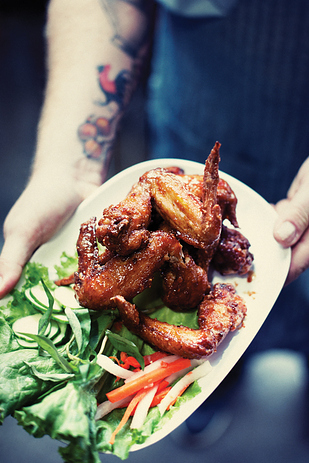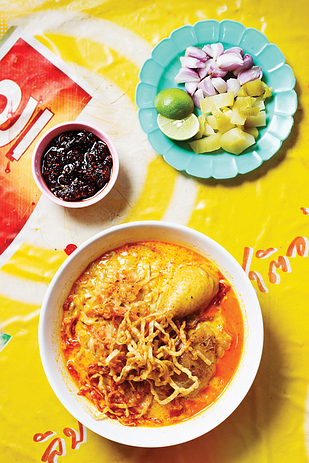1. Beetle chile relish
Naam phrik num is a fiery green-chile relish popular in Northern Thailand that serves as a dip for things like sticky rice, pork cracklings, and steamed vegetables. Many versions are seasoned with maengda, an uncomfortably large cockroach-looking beetle that lends a surprisingly welcome floral, almost blue cheese-like character.
2. Slow-grilled pig boob
Speaking of snout to tail (or bug-eyes to webbed feet?), frog ends up in many dishes in Northern Thailand and cooks make use of virtually every bit. Instead of serving just the legs, like those picky French, Thai cooks often hack up the whole skinned amphibian for soups and stews. (I like to call this, “everything but the ribbit.”) Sometimes the leftover skin gets dried out then deep-fried for a crunchy snack, as in this photo. Taken after way too much whiskey at a roadside drinking establishment outside of Chiang Mai, it’s as blurry as my vision was at the time.
Wherever we went, Andy did the ordering. This was good because most of the time I didn’t know what anything was and even if I did I couldn’t speak enough Thai to order it. What arrived at the table was often a surprise. The bowl in the back of this photo from our trip, for instance, contained a murky, meaty broth seasoned with fresh herbs and chunks of aromatics like galangal. I eagerly dug in only to discover that it was really bitter—a flavor much loved in this part of the country. Why? I asked Andy. Beef bile, he said. It’s produced by the liver of most vertebrates, aids in digestion, and comprises 85% water, 10% bile salts, 3% mucus and pigments, 1% fats, and 0.7% inorganic salts. That 3% will get ya.
In Northern Thailand, many meals come with a plate piled with leaves plucked from the side of road that you’re meant to nibble between bites of whatever else you’re eating. How lovely, I thought, as I tried one that tasted kind of like cilantro. Then I kept sampling: The next leaf was as bitter as anything I’ve ever eaten, another tasted inexplicably and unmistakably like grilled fish, and another’s flavor reminded me of nothing so much as Sweet’N Low.
Cooks in the North and Northeast of Thailand do use the sanitized bottled fish sauce we’re used to in the States. But they reserve their most ardent affection for this other stuff, on offer at a market in Chiang Mai: Fish mixed with salt and rice and left to ferment into a fragrant sludge called plaa raa. It’s especially funky, but eat it in enough dishes, from papaya salads to chile relishes to curries, and you begin to crave its pungency. I only ate it cooked, which I’ve heard is a great way to avoid liver parasites.
The Northern Thai version of laap (often spelled “larb” in our neck of the woods) is extremely delicious and very different from the tart, spicy Northeastern version popular in the U.S. Essentially, it’s finely minced meat (pork, chicken, fish, water buffalo, barking deer—whatever!) mixed with cooked organs and skin, fresh herbs, fried garlic and shallots, and a dried spice–heavy seasoning paste. Andy prefers the raw version that old-timers eat, a sort of tartar of uncooked flesh and blood. This one he made with his friend Sunny. We ate it with sticky rice and herbs at a Thai military base.
Since the lighting at this outdoor spot in the village of Ban San Sai wasn’t exactly studio quality, I might not win an award for this snap of denatured pig brain. Brain is one of those foods that sounds horrible but is actually amazing. For this dish, it had been mushed up with curry paste, wrapped in a banana leaf, and grilled to create a sort of rich, complexly delicious custard that I swear could sell for $28 at the right restaurant in Manhattan. The woman who served us told us in Thai that eating it would make us smart. I choose to think she wasn’t joking.
Pork blood enriches many Thai dishes, and some do contain a little blood that never gets cooked. Luu, on the other hand, is essentially an entire bowl of disturbingly red raw blood topped with kaffir lime leaves and fried pork skin. It tasted a lot better than I expected—rich and irony—though I would’ve welcomed a much smaller bowl.
Unfortunately, none of those recipes made it into the cookbook. Instead, it’s stuff like this:
Ike’s Vietnamese Fish Sauce Wings
Austin Bush
Northern Thai Curry Noodle Soup with Chicken











